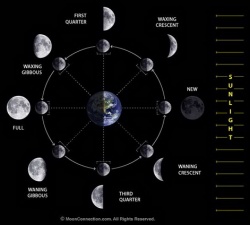Uposatha
The Uposatha (Sanskrit: Upavasatha) is Buddhist day of observance, in existence from the Buddha's time (500 BCE), and still being kept today in Buddhist countries. The Buddha taught that the Uposatha day is for "the cleansing of the defiled mind," resulting in inner calm and joy. On this day, lay disciples and monks intensify their practice, deepen their knowledge and express communal commitment through millennia-old acts of lay-monastic reciprocity. On these days, the lay followers make a conscious effort to keep the Five Precepts or sometimes the 8-precepts. It is a day for practicing the Buddha's teachings and meditation.
Observance days
Depending on the culture and time period, uposatha days have been observed from two to six days each lunar month.
Theravada countries
In general, Uposatha is observed about once a week in Theravada countries in accordance with the four phases of the moon: the new moon, the full moon, and the two quarter moons in between. In some communities, such as in Sri Lanka, only the new moon and full moon are observed as uposatha days.
In Burma, Uposatha (called ဥပုသ် ubot nei) is observed by more pious Buddhists on the following days: waxing moon (လဆန်း la hsan), full moon (လပြည့်နေ့ la pyei nei), waning moon (လဆုတ် la hsote), and new moon (လကွယ်နေ့ la kwe nei). The most common days of observance are the full moon and the new moon. In pre-colonial Burma, the Uposatha day (commonly rendered as the Buddhist Sabbath in English) was a legal holiday that was observed primarily in urban areas, where secular activities like business transactions came to a halt. However, since colonial rule, Sunday has replaced the Uposatha day as the legal day of rest. All major Burmese Buddhist holidays occur on Uposatha days, namely Thingyan, the beginning of the Buddhist lent (beginning in the full moon of Waso, around July to the full moon of Thadingyut, around October). During this period, Uposatha is more commonly observed by Buddhists than during the rest of the year. During Uposatha days, Buddhist monks at each monastery assemble and recite the Patimokkha (a concise compilation of the Vinaya.
For a 2012 calendar of Thai uposatha days, see John Bullitt's "Calendar of Uposatha Days."
Mahayana countries
In Mahayana countries that use the Chinese calendar, the Uposatha days are observed six times a month, on the 8th, 14th, 15th, 23rd and final two days of each lunar month. In Japan, these six days are known as the roku sainichi (六斎日 Six Days of Fasting?).
Names of Full Moon Uposatha Days
The Pali names of the uposatha days are based on the Sanskrit names of the nakśatra (Pali: nakkhatta), the constellations or lunar mansions through which the moon passes within a lunar month.
1. Observance of the Eight Precepts;
2. Bi-weekly recitation of the Vinaya rules by a chapter of Buddhist monks
The uposatha are the days of the full moon, half moon and the two quarter moons of each month in the ancient Indian calendar. The day of the full moon (puṇṇamā) was the most important uposatha and marked the beginning of the month. In pre-Buddhist times the upavasatha was the fasting day preceding the Vedic sacrifice. This Sanskrit word and its Pāḷi equivalent mean something like ‘fulfilled.’ In some ways the uposatha is similar to the Jewish and Christian Sabbath, except, of course, that it is not obligatory to observe it. However, the Buddha certainly recommended lay Buddhists use these holidays to ‘purify the soiled mind in the right way’ (upakkilittassa cittassa upakkamena pariyodapana, A.I,207). He encouraged them to pay homage to their parents on such days, to do good works, spend timein quiet contemplation and abide by the eight Precepts (A.I,143; 207). To use the uposatha for such activities was, he said, like polishing a tarnished mirror (A,I,209). He praised reserving the uposatha days for such activities in these words: ‘Pearl, crystal, beryl and gold are not worth a sixteenth of the uposatha made whole with the eight Precepts. Nor is it outshone by the moon and the celestial bodies.’ (A.I,215).
Until the introduction of the Gregorian calendar in most Buddhist countries, the uposathas were public holidays. In Sinhalese they are called poya, in Burmese ubot nei, in Chinese shuo wang, and in Japanese roku sainichi. Monks and nuns use the full and half moon uposathas to chant the Pātimokkha in congregation.
